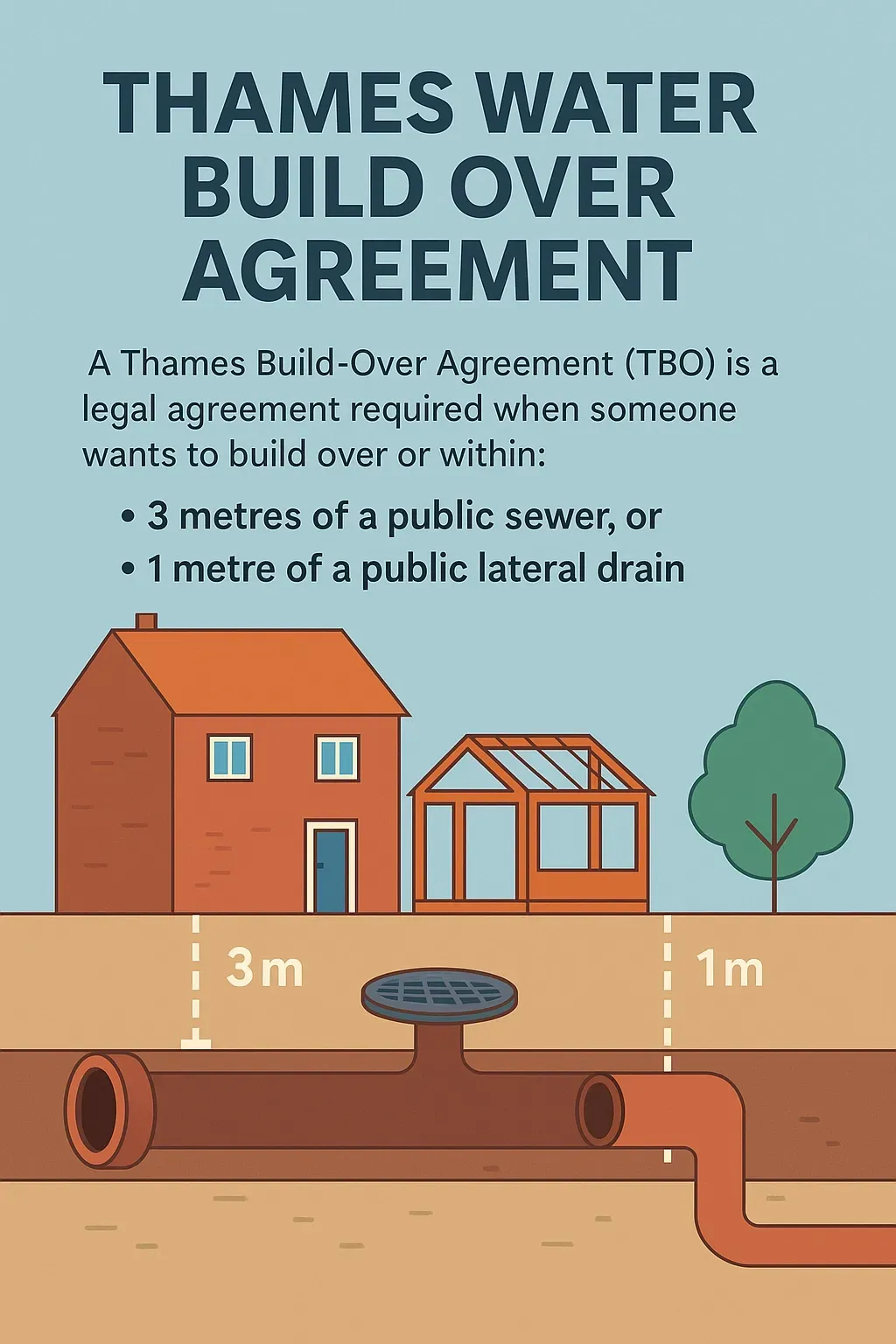While many are familiar with ‘red tape’ such as Planning Permission and Party Wall Agreements, obtaining a Thames Water Build Over Agreement is somewhat of a lesser-known process.
Building Regulation H4 requires that homeowners obtain approval from their local water authority if buildings or other works take place within 3m of a public sewer or within 1m of a public lateral drain.
In the Thames Water area, this is called a
Thames Water Build Over Agreement (TBO). If Thames Water doesn’t own and maintain the drains in your area, you’ll need to obtain approval from the authority that does.
Here’s what you need to know about the Thames Water Build Over Agreement and similar agreements with water authorities.
What is a Thames Water Build Over Agreement?
A Thames Build-Over Agreement (TBO) is a legal agreement required when someone wants to build over or within:
- 3 metres of a public sewer, or
- 1 metre of a public lateral drain
Drains are a consideration for any house extension. Even when the authority doesn’t own the drain, it can still cause problems when laying foundations or flooring. So it’s crucial to obtain information about drains on your property, regardless of who they belong to.
The agreement is made between the property owner planning the work and the water company responsible for the sewer or drain.
In short, a TBO or similar agreement sets out the conditions for the construction work, including the design and construction standards, inspection requirements, and any other restrictions for the area above the sewer or drain.

When do I need a Thames Water Build Over Agreement?
A TBO is required for any building work that affects a public sewer or drain, including building an extension, conservatory, or garage. You’ll also need one for some types of landscaping work, such as installing a garden pond or swimming pool.
Failing to obtain a TBO before carrying out construction work can result in major issues, including significant fines and legal action.
When you plan a house extension, drain plans will be produced which locate any privately owned drains or those owned by the local water authority.
Both are relevant, as these rules are in place to prevent obstructed access to the drain
and
the risk of structural collapse resulting from a drain caving in.
In addition, you’ll need Building Control to sign off the works when your extension is complete, and they won’t be able to do this if you’ve failed to obtain an agreement. This will make it difficult to sell your home.
So, this isn’t merely a bureaucratic process – the longevity of your house extension depends on it!
About the application process
In many cases, applying for permission is pretty straightforward.
If a small drain is identified that interferes with work, you’ll first need to carry out a self-certified build over agreement. This applies if you’re building over or near a domestic sewer with a diameter of 160mm or less. Thames Water will grant this if plans pose a low risk to the sewer and pipes.
If you a) can’t answer the self-certified questionnaire or b) are building over a sewer with a diameter over 160mm, you’ll need to gain an approved build over agreement.
This involves an application fee. In this situation, Thames Water often carries out a pre-construction CCTV (camera) survey to check the pipes. In addition, they may need to repair any issues prior to work taking place.
If the sewer happens to be larger than 375mm, then Thames Water may need to enter the sewer to undertake a more advanced survey.
Finally, if you can’t self-certify the works, fees are not inconsiderable, ranging from around £300 for smaller drains to £1,300 for the largest (375mm and above).
Locating your drains
So, how do you know where your outside drains are? And how can you determine if these are owned and maintained by the water authority? It can be tricky!
To determine whether or not you need a TBO, you need to locate and map the drains. In most cases, the drains are positioned well out the front of the house, where they cause no issues.
However, in urban areas, sewers often run beneath back gardens – and this is when you’re most likely to need approval.
The first step is to search for a manhole on the property. You might already be aware of a manhole or cover in your garden. If you discover one, you can remove the manhole to expose the pipework below. If the pipes form a junction, then your property is part of a shared pipework connected to other properties.
To check whether it’s a public sewer, visit your local authority offices or
use this facility for Thames Water.
Unfortunately, almost half of public sewers in the Thames Valley region don't appear on records as they were privately owned before 2011.
If you can’t determine the status of the drain or sewer, you can contact Thames Water (or any other sewage company) to obtain what records you can. You may also find details on your property deed. Citizens Advice have a
useful article on this here.
TBOs: step-by-step
The process of obtaining a Thames Build-Over Agreement (TBO) typically involves the following steps:
- Determine whether a TBO is required: Before beginning any construction work, it is essential to check whether it will affect a public sewer or drain. This should take place before applying for Planning Permission. While the rules differ between water authorities, Thames Water sets the limit at 3m or less of a public sewer or 1m or less from a public lateral drain. Public and lateral drains can be found in the front or back garden, but only drains in the back garden are likely to cause issues (as very few extensions are built facing the public highway).
- Submit an application: Once you’ve determined that a TBO is likely required, it’s time to start the application with the water and sewerage company responsible (Thames Water in much of London, south and central England). First, you’ll be asked to complete a questionnaire allowing you to self-certify. Your surveyor and/or architect can advise on this.
- Review and approval: The water company will review the application and determine whether the proposed construction work meets their safety and maintenance requirements. This may involve inspections of the site. If the application is approved, the water and sewerage company will issue a TBO.
- Construction work: Once the agreement is issued, the property owner can proceed with the construction work, subject to the conditions set out in the agreement.
- Completion and inspection: A final inspection is required to obtain Building Regulation approval. A certificate will confirm the work was carried out in line with the agreement.
The process of obtaining a TBO is often simple, but in some cases, it’s bound to be complex and time-consuming.
If you have a large manhole right where you intend to construct, you’ll probably need to plan for a full-blown inspection.
Your surveyor or architect will advise on this. Always obtain the agreement before starting work – the sooner you find out, the better.
Summary: Thames Water Build Over Agreement
Thames Builder Over Agreements certainly don’t apply to every project, but they’re always a consideration when construction takes place near a public sewer or drain.
Determining the position and status of the drain can be tricky – the first thing to do is look for a manhole or other opening within 3m of where you intend to build (or 1m if it’s a public lateral drain).
The process of obtaining an agreement can be simple if the drain is small and works are straightforward. But, if foundations need to be dug into the ground near the drain, or the drain is larger than average, then it’s wise to prepare for a survey.
Fast Plans have decades of experience in house extension planning and design. Please
contact our friendly team and we’ll be happy to discuss your plans with you.
Ready to get started?
Fixed-price packages with everything included. Call 0208 154 5569 now or request a callback below.
Related posts


